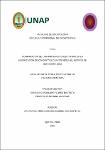Comparación de lima protaper gold y mtwo en la modificación de conductos curvos según el método de Schneider, 2022

Date
2023Author
Flores Bautista, Genesis Guadalupe
Nina Andrade, Ernesto Elías
Metadata
Show full item recordAbstract
The purpose of this research work was the comparison of the Protaper Gold and Mtwo files in the modification of curved canals according to the Schneider method, 2022. The research was of a quantitative type, of an experimental design, of the quasi-experimental type. The study population was the mesiobuccal canals of 40 permanent mandibular first molars, of which 20-mesiobuccal canals were used for each rotary system. The data collection sheet for the angle of curvature according to the Schneider method was used as an instrument. The most relevant results were: Before instrumentation, the most frequent degree of curvature of the mesiobuccal canals selected for the Protaper Gold file was 30° and 32° with 15% each. Before instrumentation, the canals presented severe angulation at 100% and at the group selected for instrumentation with the MTWO file was 24°, 25° and 30° with 15% each, presented a severe angulation of 55% and a moderate angulation of 45%. After instrumentation with the MTWO file, the most frequent degree of curvature was 23° with 15%, and they presented severe angulation of 55% and moderate angulation of 45%. The mean angle of the teeth to work with Protaper Gold was 32.10° and decreased 1.5° with the instrumentation, reaching 30.60°. The mean of the angle of the group of teeth to work with Mtwo was 25.55° and decreased with the instrumentation 1.8°, reaching 23.75°. There is no significant difference in the Protaper Gold group before and after instrumentation (p=0.289). There is a significant difference in the MTWO group before and after instrumentation (p=0.000). El propósito de este trabajo de investigación fue la comparación de lima Protaper Gold y Mtwo en la modificación de conductos curvos según el método de Schneider, 2022. La investigación fue de tipo cuantitativa, de diseño experimental, del tipo cuasi experimental. La población de estudio fueron los conductos mesiovestibulares de 40 primeras molares inferiores permanentes, de las cuales se utilizó 20 conductos mesiovestibulares para cada sistema rotatorio. Se usó la ficha de recolección de datos para el ángulo de la curvatura según el método de Schneider como instrumento. Los resultados más relevantes fueron: Antes de la instrumentación el grado de curvatura más frecuente de los conductos mesiovestibulares seleccionados para la lima Protaper Gold fue de 30° y 32° con el 15% cada uno, antes de la instrumentación los conductos presentaron una angulación severa al 100% y en el grupo seleccionado para la instrumentación con la lima MTWO fue de 24°, 25° y 30° con el 15% cada uno, presentaron una angulación severa de 55% y moderada de 45%. Después de la instrumentación con la lima Protaper Gold el grado de curvatura más frecuente fue 25° con el 20%, después de la instrumentación los conductos presentaron una angulación severa al 100%. Después de la instrumentación con la lima MTWO el grado de curvatura más frecuente fue de 23° con el 15%, y presentaron una angulación severa de 55% y moderada de 45%. La media del ángulo de dientes a trabajar con Protaper Gold fue 32.10° y disminuyó con la instrumentación 1.5°, llegando a medir 30.60°. La media del ángulo del grupo de dientes a trabajar con Mtwo fue 25.55° y disminuyó con la instrumentación 1.8°, llegando a medir 23.75°. No existe diferencia significativa en el grupo de Protaper Gold antes y después de la instrumentación (p=0,289). Existe diferencia significativa en el grupo MTWO antes y después de la instrumentación (p=0,000).
Collections
- Tesis [188]

